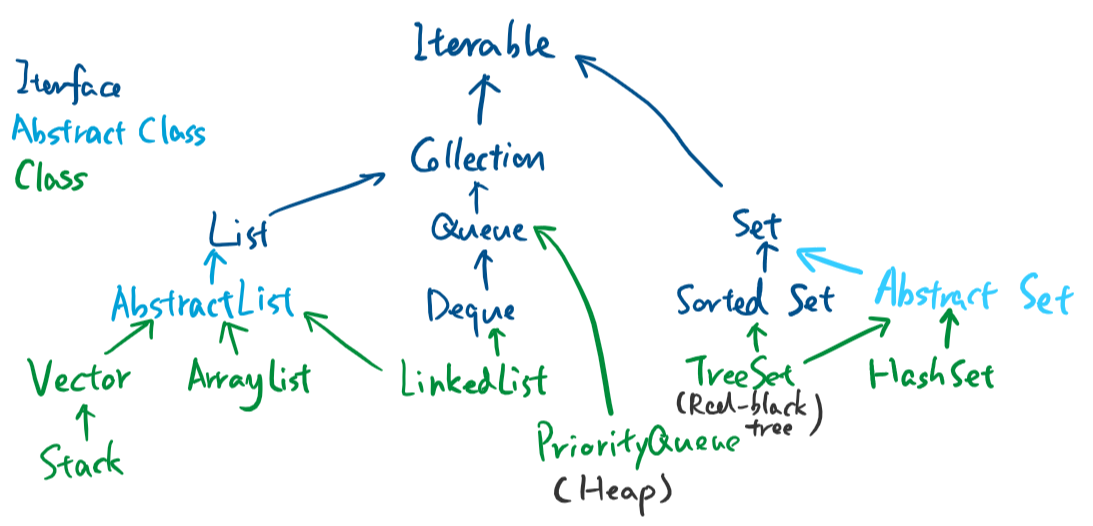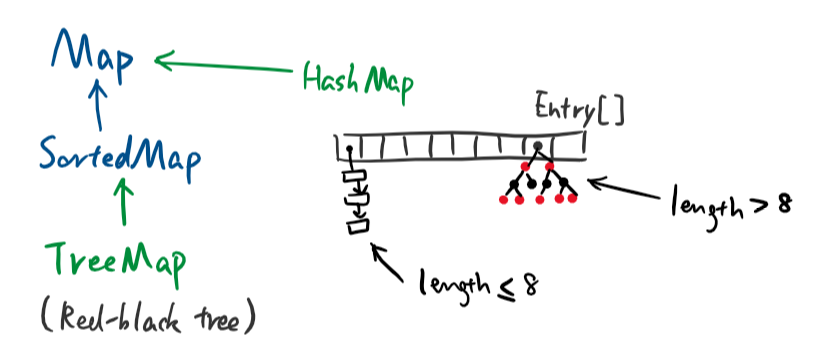Java 对应数据结构可用的类型

队列
ref: https://docs.oracle.com/javase/11/docs/api/java/util/Queue.html
Queue接口
Queue:基本上都是先进先出(反例:Priority Queue, LIFO Queue/Stack)
All Superinterfaces: Collection<E>, Iterable<E>
All Known Subinterfaces: BlockingDeque<E>, BlockingQueue<E>, Deque<E>, TransferQueue<E>
方法
有exception的:
- add: 入队一个元素并返回true。如果无法入队(比如队列容量固定,并超出容量了),
IllegalStateException。这个方法是从Collection<E>接口来的。 - remove: 队列开头的元素出队(并返回该元素)。如果队列为空,
NoSuchElementException。 - element: 返回开头元素但不出队。如果队列为空,
NoSuchElementException。
没exception的:
- offer: 入队一个元素并返回true。如果无法入队,返回false。
- poll: 队列开头元素出队(并返回该元素)。如果队列为空,返回null。
- peek: 返回开头元素但不出队。如果队列为空,返回null。
其他接口
- BlockingQueue:线程安全的Queue(但Collection的批处理操作不是现成安全的
addAll,containsAll,retainAll,removeAll)。offer和poll可以指定timeout,在无法入队、无法出队(队为空)的情况下等待一段时间,直到可以出入队。不允许放null。 - Deque (Double-ended Queue): 头和尾都能出入队的队列。各种方法都有First和Last (e.g. pollFirst, pollLast)
- BlockingDeque
- TransferQueue: 一种BlockingQueue。这种队列里,producer可以等consumer接收元素。可以有一堆consumer等着拿东西。。。
现成的可用的类
LinkedList
是List,也是Deque,基于双向链表实现。
add, remove: O(1)
get: O(n)
ArrayDeque
是List,也是Deque,基于循环数组实现。不允许存放null。
据API说,作为队列时很可能比LinkedList快,作为栈时很可能比Stack快。
This class is likely to be faster thanStackwhen used as a stack, and faster thanLinkedListwhen used as a queue.
add, remove: O(n)
get: O(1)
PriorityQueue
基于最小堆(完全二叉树)的队列,自带排序的队列,也因为自带排序,并不是先进先出,而是小的先出。默认小的元素放前面,也可以在构造的时候指定一个Comparator。如果想换成最大堆,new PriorityQueue((x,y)->(y-x))就行了。
poll, remove, peek, element都是访问队头。
get, add, offer, remove, poll: O(log(N))
栈
栈可以使用push和pop方法。
推荐使用Deque接口,ArrayDeque或者LinkedList都可以。
不推荐使用Stack类(不过它是synchronized的):
- Stack继承Vector,而Vector有效率问题
- 与Deque相比,只能从一个方向进出
Stack的方法有push, pop, peek。以及,虽然它叫stack,但由于它是用List做的,其实还是有一些会破坏stack意义的方法的,可以按index进行get, insert, remove…
注意:如果使用了Stack的Iterator,返回的顺序是由堆底至堆顶。而用Deque的Iterator时(使用push入栈时),返回顺序是堆顶至堆底。
堆
使用PriorityQueue, 见上文。
哈希

Set
- Set是Iterable,也是Collection,所以可以forEach也可以toArray
HashSet
方法:add, remove, size, isEmpty, clear
注意clone方法是shallow copy,复制出的Set里面的元素还是那些地址。
Map
- Map不是Iterable的(SortedMap是Iterable的)
- Hashtable是线程安全的,但不接受null (没写错,table就是小写的…)。每次同步执行时都锁定整个结构。ConcurrentHashMap同步时锁的颗粒度更小,所以更推荐使用。
- HashMap是非线程安全的,但可以接受null。Collections.synchronizedMap(HashMap)时几乎等同于Hashtable,靠锁住整个Map来进行同步。
方法: get, put, remove, size, isEmpty, containsKey, containsValue
keySet返回所有key, putAll可以用于复制另一个Map全部键值(注:如有重复的键,值会覆盖)
Ref:
